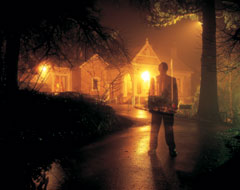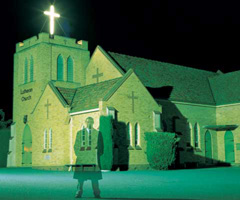SPIRIT & VISION
 |
 |
 |
 |
 |
 |
 |
 |
 |
Darren Siwes - - -
Lest We Forget: the Photographic Art of Darren Siwes, by Christine Nicholls
Siwes’ distinctive images of Adelaide’s urban milieux, landmarks and cultural landscapes, into which he interpolates his own image as a kind of uncanny, ghostly memento mori, and simultaneously, as an epiphanic, contemporary Indigenous presence, have become emblematic of his photographic art. What renders these photographs ‘distinctly Siwes’ is his refusal of the stereotype, along with his insistence on the continuity of the past with the present.
The fact that the spectral figure (Siwes) wears a well-tailored suit is significant in terms of the meaning and deconstructive purpose of his photography, because even a generation ago suits were affordable by relatively few Australian Aboriginal people. There exists a plethora of early colonial photographs showing Aboriginal men wearing the cast-off, ill-fitting hand-me-down suits of well-heeled middle-class whites, and Siwes’ photographs intrinsically challenge that historical and optical legacy. Siwes’ figure in the landscape has dignity and authority, and his vestimentary code confirms and enhances his claim on the social space. Siwes’ photographs have the capacity par excellence to disrupt powerful and entrenched stereotypical thinking about Indigenous Australians and their contemporary identities.
Siwes arranges each of his photographs with a high level of intentionality. Every shot is lovingly and painstakingly composed. Darren Siwes always carefully selects his sites. Nothing is left to chance in terms of where Siwes places his camera in relation to the buildings and monuments that he photographs.
Siwes deliberately and strategically juxtaposes ‘his’ Indigenous figure in relation to what could be regarded as the most representative ‘sacred sites’ ‘belonging’ to the white man in the Adelaide area – for instance, Adelaide’s famous North Terrace. The buildings and monuments lining North Terrace are expressions, or 'symbols', of South Australian colonial identity and they also speak to the continuing hegemony of the Adelaide establishment. It is this dubious visual and material cultural record of (South) Australian colonial history that Siwes seeks to critique by means of his photography. In all of Siwes’ photographs, no matter what the location, there is evidence of a pre- and still- existing Indigenous presence. That presence is a confident one, and certainly not that of an apologetic shade.
Siwes refuses to let us forget that Adelaide is the home of the Kaurna people. Whether he is photographing the Old Gum Tree at Glenelg, site of the proclamation of South Australia in 1836, or Rundle Mall’s famous “Beehive Corner”, a popular meeting place for members of the Adelaide bourgeoisie, or the city’s solid Victorian buildings, the stately private homes of its respectable burgers, Darren Siwes honours that enduring Indigenous occupancy, which he does not regard as something consigned to the past. His photographic art constitutes an implicit challenge to what has been described as ‘the white blindfold view of history’, and to the doctrine of terra nullius. By compressing time and space through the camera’s eye, Siwes interrogates of all of the colonizers’ major institutions: the Christian Church, a predominantly white spiritual meeting place in what has been described as “the City of Churches’; and even that holy of holies, the War Memorial, where the heroic deeds of the (mostly) non-Indigenous dead, the fallen, are enshrined and commemorated.

One Night at Mt. Lofty 2000

I am expecting 2000

CHURCH 1 2002
Cibachrome photographs - 100x120cm
Courtesy of Greenaway Art Gallery